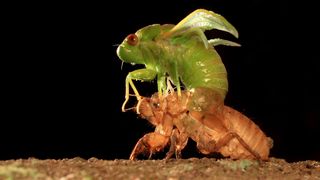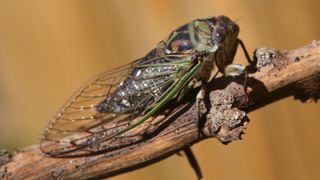Cicadas: Facts about the loud, seasonal insects
Cicadas are responsible for nature's summer soundtrack in much of the U.S.

Cicadas are winged insects that produce a loud buzzing song that can be heard throughout the summer, and they live on every continent except Antarctica. Annual cicadas appear each year in late June through August. Periodical cicadas, found only in parts of North America, emerge from late April through early May in a cycle that spans 13 or 17 years, depending on the species.
What do cicadas look like?
There are around 3,400 cicada species, of which seven are periodical cicadas (three 17-year cicada species and four 13-year cicada species), according to Scientific American. All cicadas have large, bulging eyes; these are usually black or green in annual cicadas, and are typically bright red in periodical cicadas (but in rare cases, periodical cicada eyes can be white, blue, yellow, or even multicolored, according to Cicada Mania).
Annual cicadas' bodies can be solid or patterned in shades of black, brown and green, and they measure about 1.75 inches (44 millimeters) long on average, according to North Carolina State University in Raleigh. Periodical cicadas' bodies are deep black and are a bit smaller than those of annual cicadas', measuring about 0.75 to 1.25 inches (19 to 32 mm) long. Cicadas' wings are veined and transparent, and darker veins near the tips of the wings in some species make the shape of a "W." They have no stingers and lack chewing mouthparts, so they can't bite. Adult females have a sharp ovipositor, a styluslike organ for egg laying, and males have ribbed tymbals — exoskeleton structures of alternating stiff and flexible membranes — on the first abdominal segment. When males rapidly expand and contract their tymbals, the vibration produces the cicada's distinctive summer song.
As juveniles, or nymphs, cicadas are white and resemble ants or termites. They grow underground by molting through several nymph stages called instars. During the last instar stage, nymphs emerge from their burrows. This aboveground nymph stage is wingless with a light-brown exoskeleton and large front limbs that it uses to anchor itself to trees, plants or tall grasses, in preparation for the final molt — into its adult form.
When adults break out of the nymph exoskeleton their bodies are soft and white, but over the next few hours their wings unfurl and their adult exoskeleton hardens and darkens — they are known as teneral adults during this transitional phase, while their bodies are still soft, according to the University of Connecticut (UConn) in Stamford. It takes about four to six days for their exoskeletons to harden completely.
How do cicadas reproduce?
That loud buzzing sound that cicadas produce is a mating call. Male cicadas sing together in choruses by vibrating their tymbals, and the song attracts both males and females that cluster together to mate. After mating, the males die and females begin to lay their eggs — approximately 20 at a time — which they insert into slits in tree branches with their ovipositors.
The eggs hatch within six to 10 weeks, and the nymphs drop from the branches to the ground, burrow into the soil and suck nutrients from plant roots.

What are cicadas' habits?
Cicadas spend most of their lives underground as nymphs, followed by a short adulthood — lasting about two to six weeks — above the ground, usually in trees near the locations where they emerge, according to the University of Michigan's Museum of Zoology.
For annual cicadas, that subterranean stage lasts two to five years, according to Texas A&M University in College Station. But for periodical cicadas, it will be 13 or 17 years before the nymphs see sunlight again. Periodical cicada nymphs typically emerge once soil temperatures reach about 64 degrees Fahrenheit (18 degrees Celsius) at a depth of 12 to 18 inches (31 to 46 centimeters).

When periodical cicadas emerge, all the nymphs in a given location appear at around the same time, give or take a few weeks, and as many as 1.5 million insects can cluster in a single acre. A group of periodical cicadas that emerge on the same cycle is called a brood. Broods are classified with Roman numerals that represent each group, and there were once 30 recognized broods spread across the northeastern United States. But over time, scientists have consolidated some broods, and other broods have vanished due to habitat fragmentation and human development; today, there are 12 active broods of 17-year cicadas and three 13-year broods, UConn reports.
Brood X, also known as the Great Eastern Brood, is the most widely distributed of the periodical cicada broods, emerging in 15 states from Illinois to New York, as far north as Michigan and as far south as Georgia. Their last appearance was in 2021, and they won't be seen again until 2038, Cicada Mania says.
What do cicadas eat?
Cicadas are true bugs (in the order Hempitera), which means that they have sucking mouthparts shaped like sharp straws, and they use them for piercing plants and sucking up the liquid inside, according to the Missouri Department of Conservation. Nymphs consume fluids in roots, while adults dine on fluid in branches, according to UConn.
Though cicadas are sometimes mistakenly called locusts, they are not part of the grasshopper order, and cicadas do not eat agricultural plants as grasshoppers do, according to The Ohio State University College of Food, Agricultural and Environmental Sciences (OSU). However, female cicadas can damage the branches of young or newly planted trees when they lay eggs with their sharp ovipositors, and this can inhibit the trees' ability to bear fruit, OSU says.
Are cicadas endangered?
While no species of cicada is endangered, a few are at risk, according to the International Union for Conservation of Nature (IUCN). The organization's Red List of Threatened Species lists the periodical cicadas Magicicada cassini, Magicicada septendecim and Magicicada septendecula as lower risk/near threatened, as those populations' habitats are severely fragmented and the number of mature individuals has been declining for decades, IUCN says.
Other cicada facts
Choruses of male cicadas can reach 80 to 100 decibels in volume — as loud as a jackhammer, according to Nature.
Cicada wings are waterproof and antimicrobial, according to Scientific American.
When cicada nymphs leave their burrows, they'll sometimes build chimneys or turrets of mud over the exit, according to Cicada Mania.
Cicada species have different songs, you can listen to some of them on the website Songs of Insects: A Guide to the Voices of Crickets, Katydids & Cicadas.
Additional resources
- General Periodical Cicada Information: University of Connecticut
- Cicada Mania: Latest Cicada News
- The Green Argument For Eating Cicadas (Plus A Few Recipes)
This article was originally written by Live Science contributor Alina Bradford and has since been updated.
Sign up for the Live Science daily newsletter now
Get the world’s most fascinating discoveries delivered straight to your inbox.

Mindy Weisberger is an editor at Scholastic and a former Live Science channel editor and senior writer. She has reported on general science, covering climate change, paleontology, biology, and space. Mindy studied film at Columbia University; prior to Live Science she produced, wrote and directed media for the American Museum of Natural History in New York City. Her videos about dinosaurs, astrophysics, biodiversity and evolution appear in museums and science centers worldwide, earning awards such as the CINE Golden Eagle and the Communicator Award of Excellence. Her writing has also appeared in Scientific American, The Washington Post and How It Works Magazine.
